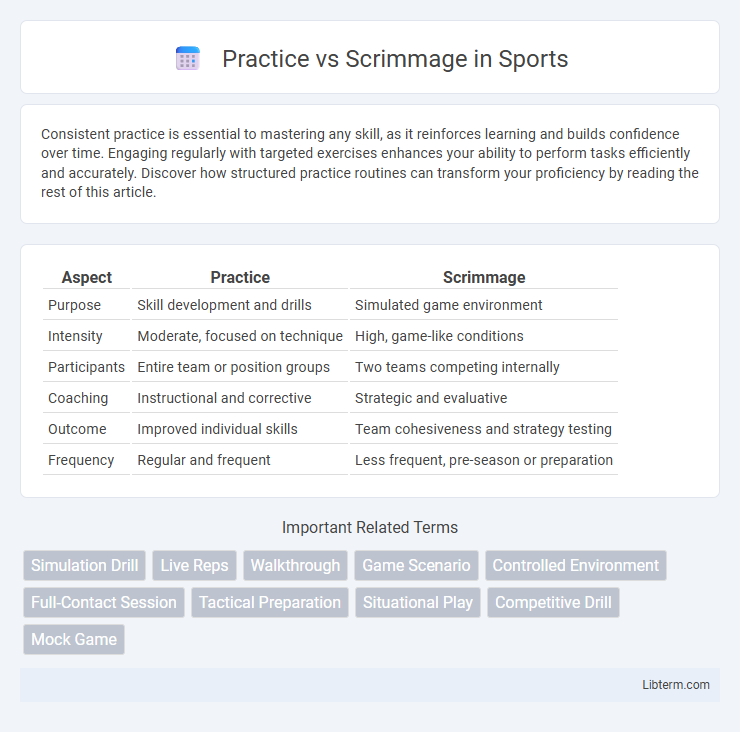Consistent practice is essential to mastering any skill, as it reinforces learning and builds confidence over time. Engaging regularly with targeted exercises enhances your ability to perform tasks efficiently and accurately. Discover how structured practice routines can transform your proficiency by reading the rest of this article.
Table of Comparison
| Aspect | Practice | Scrimmage |
|---|---|---|
| Purpose | Skill development and drills | Simulated game environment |
| Intensity | Moderate, focused on technique | High, game-like conditions |
| Participants | Entire team or position groups | Two teams competing internally |
| Coaching | Instructional and corrective | Strategic and evaluative |
| Outcome | Improved individual skills | Team cohesiveness and strategy testing |
| Frequency | Regular and frequent | Less frequent, pre-season or preparation |
Understanding the Difference: Practice vs Scrimmage
Practice involves structured drills and skill-building exercises aimed at improving individual and team performance, focusing on technique, conditioning, and strategy development. Scrimmage simulates actual game conditions, allowing players to apply skills in a competitive environment without the pressure of official competition. Differentiating practice from scrimmage is crucial for coaches to balance skill refinement with game readiness effectively.
Core Objectives of Practice Sessions
Practice sessions primarily focus on skill development, technique refinement, and strategic understanding of the game. Core objectives include improving individual player fundamentals, enhancing team chemistry, and implementing coaching strategies in a controlled environment. These sessions emphasize repetition and feedback to prepare athletes for the intensity and unpredictability of scrimmages and actual competitions.
Key Purposes of Scrimmage Activities
Scrimmage activities primarily simulate real-game scenarios to enhance player decision-making, teamwork, and strategy execution under competitive conditions. These sessions emphasize situational awareness and communication, fostering the transition from practice drills to actual game performance. Coaches use scrimmages to assess individual skills, identify tactical weaknesses, and prepare athletes for the intensity and unpredictability of live competition.
Skill Development in Practice
Practice sessions emphasize deliberate skill development through repetitive drills targeting specific techniques, ensuring players refine fundamentals and correct errors. Coaches use structured exercises during practice to build muscle memory, improve agility, and enhance decision-making under controlled conditions. In contrast, scrimmages simulate game situations, offering opportunities to apply skills dynamically but with less focused skill refinement.
Game Simulation through Scrimmage
Scrimmage provides a realistic game simulation that mimics actual match conditions, allowing athletes to practice strategic plays and in-game decision-making under pressure. Unlike regular practice drills, scrimmages enable players to experience live opponents and dynamic gameplay, enhancing situational awareness and teamwork. This immersive environment sharpens competitive skills and prepares teams for real-game scenarios more effectively.
Structure and Organization: Practice vs Scrimmage
Practice sessions emphasize skill drills, repetition, and coach-directed activities designed to improve individual and team techniques. Scrimmages simulate real game conditions with structured, competitive play to enhance decision-making, situational awareness, and teamwork under pressure. Both are organized with specific objectives, but practices focus on controlled learning environments while scrimmages prioritize dynamic game-like experience.
Measuring Progress in Practice Settings
Measuring progress in practice settings involves tracking specific performance metrics such as skill accuracy, decision-making speed, and consistency during drills. Practice sessions allow for controlled repetition and targeted feedback, enabling precise evaluation of an athlete's development over time. Unlike scrimmages, practices provide a structured environment where incremental improvements can be systematically monitored and quantified.
Testing Team Dynamics with Scrimmage
Scrimmages serve as crucial testing grounds for team dynamics, allowing coaches to observe player interactions and decision-making in game-like scenarios. Unlike regular practice drills, scrimmages simulate real match conditions, providing insights on communication, strategy execution, and adaptability under pressure. This environment helps identify strengths, weaknesses, and chemistry within the team, refining overall performance for competitive play.
Benefits and Limitations of Practice
Practice sessions enhance individual skills through repetitive drills and focused coaching, promoting muscle memory and technical precision. They offer a controlled environment with fewer variables, allowing athletes to correct errors and build foundational techniques. Limitations include lower game intensity and realistic pressure, which can reduce readiness for unpredictable in-game scenarios.
Advantages and Challenges of Scrimmage
Scrimmages provide a realistic game environment that enhances player decision-making, teamwork, and physical conditioning by simulating actual competitive scenarios. They expose athletes to unpredictable situations, fostering adaptability and improving on-field communication under pressure. Challenges include the risk of injury due to increased intensity and potential for reduced focus on specific skill development compared to controlled practice drills.
Practice Infographic

 libterm.com
libterm.com